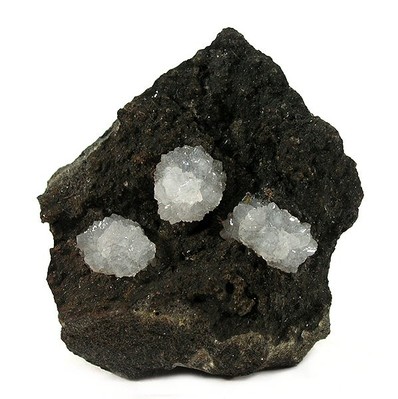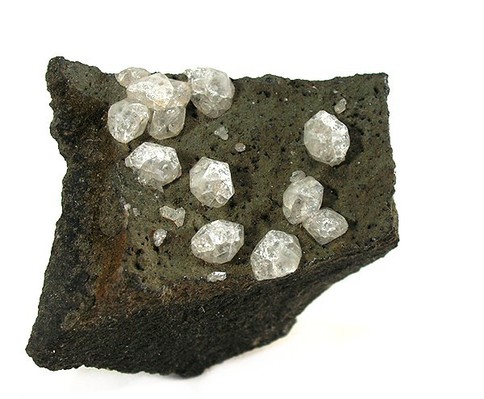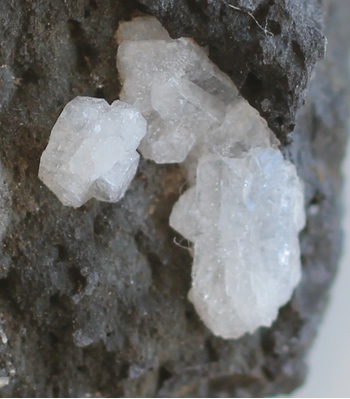Collingwood, City of Yarra, Victoria, Australiai
| Regional Level Types | |
|---|---|
| Collingwood | - not defined - |
| City of Yarra | Municipality |
| Victoria | State |
| Australia | Country |
This page is currently not sponsored. Click here to sponsor this page.
Largest Settlements:
| Place | Population |
|---|---|
| Collingwood | 5,500 (2017) |
No description has been added for this locality. Can you add one?
Select Mineral List Type
Standard Detailed Gallery Strunz Chemical ElementsMineral List
Mineral list contains entries from the region specified including sub-localities11 valid minerals. 1 erroneous literature entry.
Detailed Mineral List:
| ⓘ Analcime Formula: Na(AlSi2O6) · H2O Description: Analcime is present as perfect water-clear trapezohedrons, less than 0.5 mm in size, with crystals of large phillipsite and phacolite. Reference: Tschernich, R. (1992): Zeolites of the World, p.49; - Birch, W. D., ed. (1989): Zeolites of Victoria. The Mineralogical Society of Victoria Inc., Special Publication No. 2, Melbourne, Australia, pp. 1-30,92,93,97 & 99 |
| ⓘ Aragonite Formula: CaCO3 Description: "Aragonite has been found generally in vesicular basalt above the zeolite zones. Mamillary calcite is a common associated carbonate. Spectacular aragonite sprays, white or yellow and measuring up to 60 mm across, have been collected. Hexagonal prisms, doubly terminated by pyramids and the faces of the prisms being horizontally striated occurred at Clifton Hill." Reference: Tschernich, R. (1992): Zeolites of the World, p.49; - Birch, W. D., ed. (1989): Zeolites of Victoria. The Mineralogical Society of Victoria Inc., Special Publication No. 2, Melbourne, Australia, pp. 1-30,92,93,97 & 99 |
| ⓘ Calcite Formula: CaCO3 Description: Ferroan calcite is by far the most common type of calcite at the F19 cuttings. Normal calcite occurs as white to cream mammillary coatings lining cavities along with aragonite crystal sprays. Reference: Birch, W. D., ed. (1989): Zeolites of Victoria. The Mineralogical Society of Victoria Inc., Special Publication No. 2, Melbourne, Australia, pp. 1-30,92,93,97 & 99 |
ⓘ Calcite var. Iron-bearing Calcite Formula: (Ca,Fe)CO3 Description: "Ferroan calcite is abundant and is intimately associated with the zeolites. The calcites are various shades of yellow, orange and brown, are translucent to opaque, and occur in a number of spectacular forms such as clubs which sometimes taper to fragile stems providing the point of attachment to the matrix; 'bow-ties'; hemispheres and nodules. The various structures are usually made up of tightly packed fibres which give a silky appearance to the specimen when held in a certain direction. Calcite also occurs as yellowish brown glassy prisms. Simple calcite rhombs are rare, although 'dog-tooth spar' is not uncommon." Reference: Tschernich, R. (1992): Zeolites of the World, p.49; - Birch, W. D., ed. (1989): Zeolites of Victoria. The Mineralogical Society of Victoria Inc., Special Publication No. 2, Melbourne, Australia, pp. 1-30,92,93,97 & 99 |
| ⓘ Chabazite-Na Formula: (Na2,K2,Ca,Sr,Mg)2[Al2Si4O12]2 · 12H2O Description: "Chabazite occurs as colourless, water-clear sparkling crystals, which usually rapidly dehydrate and become opaque and crazed upon exposure. Micro crystals are very much less affected. The crystals are always twinned, and simple chabazite rhombs, or forms dominated by the rhomb, have never been observed in Melbourne Basalt. The 'phacolite' form and complex clusters based on this unit, are exceedingly common and alternative forms are rare. The terminal plane is always domed and has a frosted or etched appearance."
Single phacolite type crystals occur up to 12 mm across and complex twin/clusters occur up to 20 mm across. Reference: B. Birch chemical analysis; - Birch, W. D., ed. (1989): Zeolites of Victoria. The Mineralogical Society of Victoria Inc., Special Publication No. 2, Melbourne, Australia, pp. 1-30,92,93,97 & 99 |
| ⓘ Gonnardite Formula: (Na,Ca)2(Si,Al)5O10 · 3H2O Description: "The gonnardite/natrolite intergrowth, considered mesolite prior to 1988, has been verified from all Melbourne localities, and occurs as small, opaque white hemispheres and tufts composed of radiating fibres and prismatic needles. The individual groups have diameters up to 6 mm, though typically are 1 to 3 mm. The groups show a variety of lustre-chalky, sub-vitreous or silky- and the prismatic needles appear quite glassy when viewed through the microscope. The clusters that have been studied are radially zoned, presenting a compact gonnargite-rich core and a soft fibrous natrolite-rich outer zone." Reference: Tschernich, R. (1992): Zeolites of the World, p.49; - Birch, W. D., ed. (1989): Zeolites of Victoria. The Mineralogical Society of Victoria Inc., Special Publication No. 2, Melbourne, Australia, pp. 1-30,92,93,97 & 99 |
| ⓘ Gypsum Formula: CaSO4 · 2H2O Description: Cited by Atkinson in 1894 Reference: - Birch, W. D., ed. (1989): Zeolites of Victoria. The Mineralogical Society of Victoria Inc., Special Publication No. 2, Melbourne, Australia, pp. 1-30,92,93,97 & 99 |
| ⓘ Huntite Formula: CaMg3(CO3)4 Description: "White nodules of huntite from Clifton Hill quarries have been identified by X-ray diffraction of old specimens of 'hydrous dolomite'. "
The original report of this materials is as follows.
"Occasionally, large and small cavities, as well as horizontal planes and joints, contain a soft white substance, of a consistence varying, when freshly exposed, from a near milky state, to that of a soft putty, of which an analysis proved it to be a hydrous dolomite. These soft masses seem gradually to part with their water, and become converted into a variety of dolomite, sometimes soft and earthy, resembling chalk; and at other times extremely hard and semi-opaline in appearance." Reference: - Birch, W. D., ed. (1989): Zeolites of Victoria. The Mineralogical Society of Victoria Inc., Special Publication No. 2, Melbourne, Australia, pp. 1-30,92,93,97 & 99 |
| ⓘ Formula: Na2Ca2Si9Al6O30 · 8H2O Locality: Corporation quarries, Clifton Hill, Collingwood, City of Yarra, Victoria, Australia - erroneously reported Description: What was originally identified as mesolite has proven to be an intergrowth of Gonnardite/Natrolite. Reference: - Birch, W. D., ed. (1989): Zeolites of Victoria. The Mineralogical Society of Victoria Inc., Special Publication No. 2, Melbourne, Australia, pp. 1-30,92,93,97 & 99 |
| ⓘ Natrolite Formula: Na2Al2Si3O10 · 2H2O Description: "The gonnardite/natrolite intergrowth, considered mesolite prior to 1988, has been verified from all Melbourne localities, and occurs as small, opaque white hemispheres and tufts composed of radiating fibres and prismatic needles. The individual groups have diameters up to 6 mm, though typically are 1 to 3 mm. The groups show a variety of lustre-chalky, sub-vitreous or silky- and the prismatic needles appear quite glassy when viewed through the microscope. The clusters that have been studied are radially zoned, presenting a compact gonnargite-rich core and a soft fibrous natrolite-rich outer zone." Reference: Tschernich, R. (1992): Zeolites of the World, p.49; - Birch, W. D., ed. (1989): Zeolites of Victoria. The Mineralogical Society of Victoria Inc., Special Publication No. 2, Melbourne, Australia, pp. 1-30,92,93,97 & 99 |
| ⓘ Opal Formula: SiO2 · nH2O Description: Cited by Atkinson in 1894. Reference: - Birch, W. D., ed. (1989): Zeolites of Victoria. The Mineralogical Society of Victoria Inc., Special Publication No. 2, Melbourne, Australia, pp. 1-30,92,93,97 & 99 |
| ⓘ Opal var. Opal-AN Formula: SiO2 · nH2O Description: Cited by Atkinson in 1894. Reference: - Birch, W. D., ed. (1989): Zeolites of Victoria. The Mineralogical Society of Victoria Inc., Special Publication No. 2, Melbourne, Australia, pp. 1-30,92,93,97 & 99 |
| ⓘ Phillipsite-Na Formula: (Na,K,Ca0.5,Ba0.5)4-7[Al4-7Si12-9O32] · 12H2O Description: "In common with chabazite, phillipsite is always found in complex twinned crystals, with smaller crystals generally showing the simple forms such as the fourling, the prismatic and cruciform eightling and clusters based on these. Varieties of the larger crystals include the 'double cross', clusters based on this twinned form, and exceedingly complex rosettes and hemispheres and blocky aggregates. In freshly opened cavities, crystals of phillipsite are colourless to water-clear, but the larger crystals, like those of chabazite, soon become translucent to opaque-white when allowed to dehydrate upon exposure." Reference: Birch, W. D., ed. (1989): Zeolites of Victoria. The Mineralogical Society of Victoria Inc., Special Publication No. 2, Melbourne, Australia, pp. 1-30,92,93,97 & 99 |
ⓘ 'Phillipsite Subgroup' Reference: Tschernich, R. (1992): Zeolites of the World, p.49; - Birch, W. D., ed. (1989): Zeolites of Victoria. The Mineralogical Society of Victoria Inc., Special Publication No. 2, Melbourne, Australia, pp. 1-30,92,93,97 & 99 |
| ⓘ Thomsonite-Ca Formula: NaCa2[Al5Si5O20] · 6H2O Description: "Thomsonite often forms smooth, translucent, grey to pale brown hemispheres with a resinous lustre. The hemispheres are up to 3 mm in diameter and are composed of elongated plates which are exceedingly thin. Other forms include compact fibrous sheafs and tuffs which retain the grey translucent appearance of the globular form. The tips of these fibres sometimes appear as if they have been partly fused together." Reference: - Birch, W. D., ed. (1989): Zeolites of Victoria. The Mineralogical Society of Victoria Inc., Special Publication No. 2, Melbourne, Australia, pp. 1-30,92,93,97 & 99 |
Gallery:
List of minerals arranged by Strunz 10th Edition classification
| Group 4 - Oxides and Hydroxides | |||
|---|---|---|---|
| ⓘ | Opal | 4.DA.10 | SiO2 · nH2O |
| ⓘ | var. Opal-AN | 4.DA.10 | SiO2 · nH2O |
| Group 5 - Nitrates and Carbonates | |||
| ⓘ | Aragonite | 5.AB.15 | CaCO3 |
| ⓘ | Calcite | 5.AB.05 | CaCO3 |
| ⓘ | var. Iron-bearing Calcite | 5.AB.05 | (Ca,Fe)CO3 |
| ⓘ | Huntite | 5.AB.25 | CaMg3(CO3)4 |
| Group 7 - Sulphates, Chromates, Molybdates and Tungstates | |||
| ⓘ | Gypsum | 7.CD.40 | CaSO4 · 2H2O |
| Group 9 - Silicates | |||
| ⓘ | Analcime | 9.GB.05 | Na(AlSi2O6) · H2O |
| ⓘ | Chabazite-Na | 9.GD.10 | (Na2,K2,Ca,Sr,Mg)2[Al2Si4O12]2 · 12H2O |
| ⓘ | Gonnardite | 9.GA.05 | (Na,Ca)2(Si,Al)5O10 · 3H2O |
| ⓘ | Mesolite ? | 9.GA.05 | Na2Ca2Si9Al6O30 · 8H2O |
| ⓘ | Natrolite | 9.GA.05 | Na2Al2Si3O10 · 2H2O |
| ⓘ | Phillipsite-Na | 9.GC.10 | (Na,K,Ca0.5,Ba0.5)4-7[Al4-7Si12-9O32] · 12H2O |
| ⓘ | Thomsonite-Ca | 9.GA.10 | NaCa2[Al5Si5O20] · 6H2O |
| Unclassified Minerals, Rocks, etc. | |||
| ⓘ | 'Phillipsite Subgroup' | - | |
List of minerals for each chemical element
| H | Hydrogen | |
|---|---|---|
| H | ⓘ Chabazite-Na | (Na2,K2,Ca,Sr,Mg)2[Al2Si4O12]2 · 12H2O |
| H | ⓘ Thomsonite-Ca | NaCa2[Al5Si5O20] · 6H2O |
| H | ⓘ Analcime | Na(AlSi2O6) · H2O |
| H | ⓘ Gonnardite | (Na,Ca)2(Si,Al)5O10 · 3H2O |
| H | ⓘ Phillipsite-Na | (Na,K,Ca0.5,Ba0.5)4-7[Al4-7Si12-9O32] · 12H2O |
| H | ⓘ Natrolite | Na2Al2Si3O10 · 2H2O |
| H | ⓘ Opal var. Opal-AN | SiO2 · nH2O |
| H | ⓘ Gypsum | CaSO4 · 2H2O |
| H | ⓘ Opal | SiO2 · nH2O |
| H | ⓘ Mesolite | Na2Ca2Si9Al6O30 · 8H2O |
| C | Carbon | |
| C | ⓘ Calcite var. Iron-bearing Calcite | (Ca,Fe)CO3 |
| C | ⓘ Aragonite | CaCO3 |
| C | ⓘ Huntite | CaMg3(CO3)4 |
| C | ⓘ Calcite | CaCO3 |
| O | Oxygen | |
| O | ⓘ Chabazite-Na | (Na2,K2,Ca,Sr,Mg)2[Al2Si4O12]2 · 12H2O |
| O | ⓘ Calcite var. Iron-bearing Calcite | (Ca,Fe)CO3 |
| O | ⓘ Aragonite | CaCO3 |
| O | ⓘ Huntite | CaMg3(CO3)4 |
| O | ⓘ Thomsonite-Ca | NaCa2[Al5Si5O20] · 6H2O |
| O | ⓘ Analcime | Na(AlSi2O6) · H2O |
| O | ⓘ Gonnardite | (Na,Ca)2(Si,Al)5O10 · 3H2O |
| O | ⓘ Phillipsite-Na | (Na,K,Ca0.5,Ba0.5)4-7[Al4-7Si12-9O32] · 12H2O |
| O | ⓘ Natrolite | Na2Al2Si3O10 · 2H2O |
| O | ⓘ Opal var. Opal-AN | SiO2 · nH2O |
| O | ⓘ Gypsum | CaSO4 · 2H2O |
| O | ⓘ Calcite | CaCO3 |
| O | ⓘ Opal | SiO2 · nH2O |
| O | ⓘ Mesolite | Na2Ca2Si9Al6O30 · 8H2O |
| Na | Sodium | |
| Na | ⓘ Chabazite-Na | (Na2,K2,Ca,Sr,Mg)2[Al2Si4O12]2 · 12H2O |
| Na | ⓘ Thomsonite-Ca | NaCa2[Al5Si5O20] · 6H2O |
| Na | ⓘ Analcime | Na(AlSi2O6) · H2O |
| Na | ⓘ Gonnardite | (Na,Ca)2(Si,Al)5O10 · 3H2O |
| Na | ⓘ Phillipsite-Na | (Na,K,Ca0.5,Ba0.5)4-7[Al4-7Si12-9O32] · 12H2O |
| Na | ⓘ Natrolite | Na2Al2Si3O10 · 2H2O |
| Na | ⓘ Mesolite | Na2Ca2Si9Al6O30 · 8H2O |
| Mg | Magnesium | |
| Mg | ⓘ Chabazite-Na | (Na2,K2,Ca,Sr,Mg)2[Al2Si4O12]2 · 12H2O |
| Mg | ⓘ Huntite | CaMg3(CO3)4 |
| Al | Aluminium | |
| Al | ⓘ Chabazite-Na | (Na2,K2,Ca,Sr,Mg)2[Al2Si4O12]2 · 12H2O |
| Al | ⓘ Thomsonite-Ca | NaCa2[Al5Si5O20] · 6H2O |
| Al | ⓘ Analcime | Na(AlSi2O6) · H2O |
| Al | ⓘ Gonnardite | (Na,Ca)2(Si,Al)5O10 · 3H2O |
| Al | ⓘ Phillipsite-Na | (Na,K,Ca0.5,Ba0.5)4-7[Al4-7Si12-9O32] · 12H2O |
| Al | ⓘ Natrolite | Na2Al2Si3O10 · 2H2O |
| Al | ⓘ Mesolite | Na2Ca2Si9Al6O30 · 8H2O |
| Si | Silicon | |
| Si | ⓘ Chabazite-Na | (Na2,K2,Ca,Sr,Mg)2[Al2Si4O12]2 · 12H2O |
| Si | ⓘ Thomsonite-Ca | NaCa2[Al5Si5O20] · 6H2O |
| Si | ⓘ Analcime | Na(AlSi2O6) · H2O |
| Si | ⓘ Gonnardite | (Na,Ca)2(Si,Al)5O10 · 3H2O |
| Si | ⓘ Phillipsite-Na | (Na,K,Ca0.5,Ba0.5)4-7[Al4-7Si12-9O32] · 12H2O |
| Si | ⓘ Natrolite | Na2Al2Si3O10 · 2H2O |
| Si | ⓘ Opal var. Opal-AN | SiO2 · nH2O |
| Si | ⓘ Opal | SiO2 · nH2O |
| Si | ⓘ Mesolite | Na2Ca2Si9Al6O30 · 8H2O |
| S | Sulfur | |
| S | ⓘ Gypsum | CaSO4 · 2H2O |
| K | Potassium | |
| K | ⓘ Chabazite-Na | (Na2,K2,Ca,Sr,Mg)2[Al2Si4O12]2 · 12H2O |
| K | ⓘ Phillipsite-Na | (Na,K,Ca0.5,Ba0.5)4-7[Al4-7Si12-9O32] · 12H2O |
| Ca | Calcium | |
| Ca | ⓘ Chabazite-Na | (Na2,K2,Ca,Sr,Mg)2[Al2Si4O12]2 · 12H2O |
| Ca | ⓘ Calcite var. Iron-bearing Calcite | (Ca,Fe)CO3 |
| Ca | ⓘ Aragonite | CaCO3 |
| Ca | ⓘ Huntite | CaMg3(CO3)4 |
| Ca | ⓘ Thomsonite-Ca | NaCa2[Al5Si5O20] · 6H2O |
| Ca | ⓘ Gonnardite | (Na,Ca)2(Si,Al)5O10 · 3H2O |
| Ca | ⓘ Phillipsite-Na | (Na,K,Ca0.5,Ba0.5)4-7[Al4-7Si12-9O32] · 12H2O |
| Ca | ⓘ Gypsum | CaSO4 · 2H2O |
| Ca | ⓘ Calcite | CaCO3 |
| Ca | ⓘ Mesolite | Na2Ca2Si9Al6O30 · 8H2O |
| Fe | Iron | |
| Fe | ⓘ Calcite var. Iron-bearing Calcite | (Ca,Fe)CO3 |
| Sr | Strontium | |
| Sr | ⓘ Chabazite-Na | (Na2,K2,Ca,Sr,Mg)2[Al2Si4O12]2 · 12H2O |
| Ba | Barium | |
| Ba | ⓘ Phillipsite-Na | (Na,K,Ca0.5,Ba0.5)4-7[Al4-7Si12-9O32] · 12H2O |
Fossils
This region is too big to display the fossil list, try looking at smaller subregions.Localities in this Region
- Victoria
- City of Yarra
- Collingwood
- City of Yarra
This page contains all mineral locality references listed on mindat.org. This does not claim to be a complete list. If you know of more minerals from this site, please register so you can add to our database. This locality information is for reference purposes only. You should never attempt to
visit any sites listed in mindat.org without first ensuring that you have the permission of the land and/or mineral rights holders
for access and that you are aware of all safety precautions necessary.












Corporation quarries, Clifton Hill, Collingwood, City of Yarra, Victoria, Australia